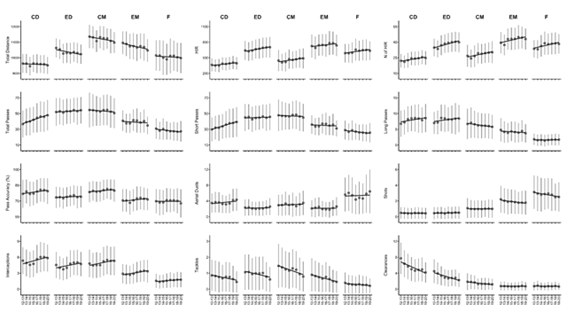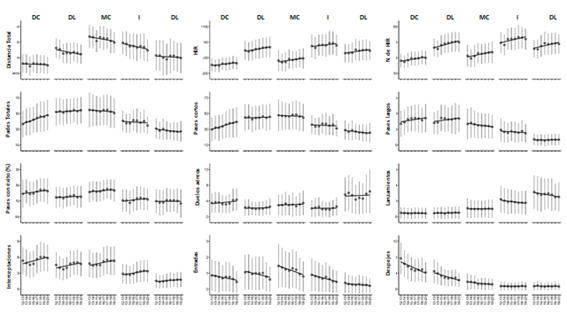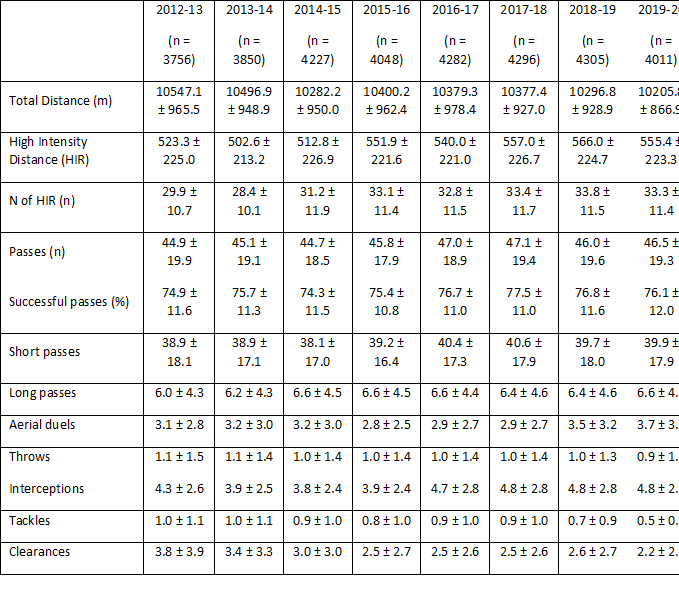January 4, 2022
Football
The evolution of physical and technical performance in LaLiga in the last ten years
As in so many other daily life activities, football also evolves. The combination of factors such as the modification of the game’s tactics and rules, use of new technologies, professionalisation of sports, or improvement in the players’ preparation has caused changes in the way of playing.1,2
Evolution of the World Cup
For example, Wallace and Norton (2014)2 studied the game’s evolution taking as a sample the final match of the World Cup in the period 1966-2010. They found a 35% increase in passes per minute and a 15% increase in ball speed. The game’s speed will increase by 5% between 2010 and 2025 and by 7% in 2030, reaching a value of around 9.8 m / s if we assume a similar trend in the future.1 In terms of physical performance, in the English Premier League between 2006/2007 and 2012/2013, the total distance covered increased by 2%. The distances covered by sprinting and high-intensity running increased between 30% and 50%.3-5 However, it seems that these physical and technical demands depend on the playing position. Players in open and attacking positions increased their distance covered at high intensity to a greater extent than central defenders and central midfielders. In contrast, central players have increased the number of passes and the completion of passes.6
Changes in LaLiga gameplay
A recent publication7 has analysed the evolution of technical-tactical and physical performance in Spanish LaLiga during eight consecutive seasons, from 2012-13 to 2019-20. The study was based on the analysis of 1,267 players who played the entire match. In total, 32,775 observations of individual performance were obtained in the competition. The footballers were classified into 5 different positions:
- centre-backs (CB, number of observations = 9089),
- full-backs (FB, number of observations = 7876),
- midfielders (MF, number of observations = 8276),
- inside forwards (I, number of observations = 3849) and
- forwards (FW, number of observations = 3585).
The physical variables considered were the following:
- the total distance traveled,
- the distance covered at a high intensity (HIR;> 21.0 km · h),
- the number of efforts at a high intensity (N of HIR).
The technical-tactical performance examined the number of passes, passing success (%), short passes, long passes, aerial duels, throws, interceptions, tackles and clearance. The players’ performance was collected using the TRACAB© tracking system used by Mediacoach©.
The results suggest some very interesting conclusions:
- The total distance covered by footballers decreased by 3.2% in the last season compared to the first in all playing positions.
- The number of high-intensity efforts increased throughout the eight seasons, with a variation that ranged between 14.6% for FB and 9.2% for I.
- However, while CB (+ 8.2%), FB (+ 9.5%), MF (+ 9.3%) and FW (+ 8.0%) increased the distance covered at a high intensity between 2012 and 2020, the I barely had differences in their performance (+ 1.7%).
- In general, no differences were found in the total number of passes, short passes, long passes and passing success.
- CBs increased the total number of passes (+ 30.6%), short passes (+ 31.5%) and long passes (+ 26.5%).
- Players made fewer tackles (-46%) and fewer clearances (-40.8%), and 10% more interceptions in the eight seasons analysed.
Although we should view these results cautiously due to football’s complex nature, they prove that football is evolving significantly at the highest level and will probably continue to change in the future. Furthermore, this evolution is not the same in all countries and competitions analysed.
Figure 1. Individual physical and technical-tactical performance in LaLiga from the 2012-13 season to 2019-20 by playing position.



References:
1 Nassis, G.P., Massey, A., Jacobsen, P., Brito, J., Morten, B., Randers, M., Castagna, C., Mohr, M., & Krustup, P. (2021). Elite football of 2030 will not be the same as 2020: Preparing players, coaches, and support staff for the evolution. Scandinavian Journal of Medicine & Science in Sports, 30(6): 962-964.
2Wallace, J. L., & Norton, K. I. (2014). Evolution of World Cup soccer final games 1966–2010: game structure, speed, and play patterns. Journal of Science & Medicine in Sports, 17, 223–228. doi: 10.1016/j.jsams.2013.03.016
3 Bradley, P. S., Archer, D. T., Hogg, B., Schuth, G., Bush, M., Carling, C., & Barnes, C. (2016). Tier-specific evolution of match performance characteristics in the English Premier League: it’s getting tougher at the top. Journal of Sports Sciences, 34, 980–987. doi: 10.1080/02640414.2015.1082614
4 Bush, M., Archer, D. T., Barnes, C., Hogg, B., & Bradley, P. S. (2017). Longitudinal match performance characteristics of UK and non-UK players in the English Premier League. Science and Medicine in Football, 1, 2–9. doi: 10.1080/02640414.2016.1233347
5 Bush, M., Barnes, C., Archer, D. T., Hogg, B., & Bradley, P. S. (2015). Evolution of match performance parameters for various playing positions in the English Premier League. Human Movement Science, 39, 1–11. doi: 10.1016/j.humov.2014.10.003
6 Yi, Q., Liu, H., Nassis, G.P., & Gómez M.A. (2020) Evolutionary Trends of Players’ Technical Characteristics in the UEFA Champions League. Frontiers in Psychology, 11:1032. doi: 10.3389/fpsyg.2020.01032
7 Lago-Peñas, C., Lorenzo-Martinez, M., López-Del Campo, R., Resta, R., & Rey, E. (2021) Evolution of physical and technical parameters in the Spanish LaLiga 2012-2019. Science and Medicine in Football, Ahead of print. 2021.
KNOW MORE
CATEGORY: MARKETING, COMMUNICATION AND MANAGEMENT
This model looks to the future with the requirements and demands of a new era of stadiums, directed toward improving and fulfilling the experiences of fans and spectators, remembering “feeling” and “passion” when designing their business model.
CATEGORY: FOOTBALL SPORTS PERFORMANCE
Through the use of computer vision we can identify some shortcomings in the body orientation of players in different game situations.
CATEGORY: MEDICINE HEALTH AND WELLNESS
A health check must detect situations which, despite not showing obvious symptoms, may endanger athletes subject to the highest demands.
CATEGORY: FOOTBALL TEAM SPORTS
In the words of Johan Cruyff, “Players, in reality, have the ball for 3 minutes, on average. So, the most important thing is: what do you do during those 87 minutes when you do not have the ball? That is what determines whether you’re a good player or not.”
CATEGORY: MEDICINE HEALTH AND WELLNESS SPORTS PERFORMANCE
Muscle injuries account for more than 30% of all injuries in sports like soccer. Their significance is therefore enormous in terms of training sessions and lost game time.
DO YOU WANT TO KNOW MORE?
- SUBSCRIBE
- CONTACT
- APPLY
KEEP UP TO DATE WITH OUR NEWS
Do you have any questions about Barça Universitas?
- Startup
- Research Center
- Corporate